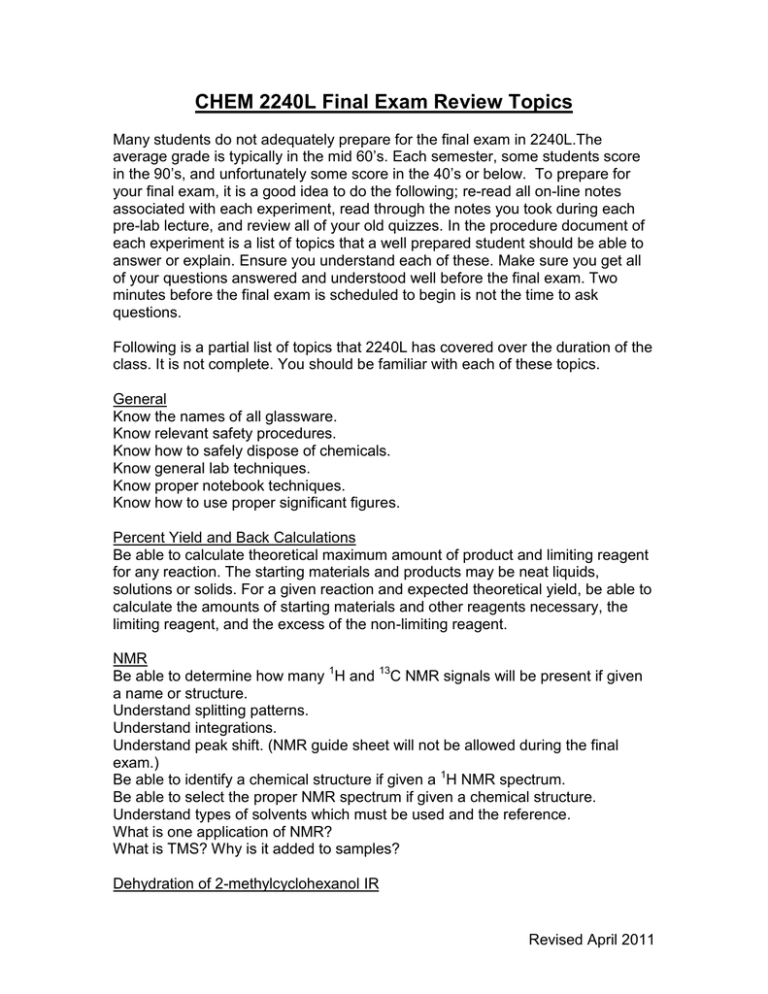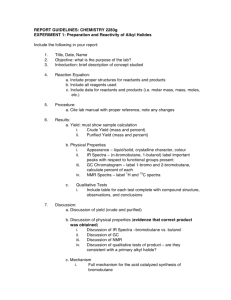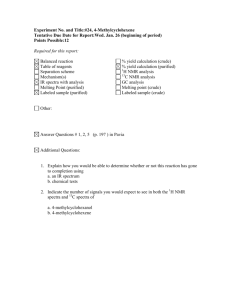CHEM 2240L Final Exam Review Topics
advertisement

CHEM 2240L Final Exam Review Topics Many students do not adequately prepare for the final exam in 2240L.The average grade is typically in the mid 60’s. Each semester, some students score in the 90’s, and unfortunately some score in the 40’s or below. To prepare for your final exam, it is a good idea to do the following; re-read all on-line notes associated with each experiment, read through the notes you took during each pre-lab lecture, and review all of your old quizzes. In the procedure document of each experiment is a list of topics that a well prepared student should be able to answer or explain. Ensure you understand each of these. Make sure you get all of your questions answered and understood well before the final exam. Two minutes before the final exam is scheduled to begin is not the time to ask questions. Following is a partial list of topics that 2240L has covered over the duration of the class. It is not complete. You should be familiar with each of these topics. General Know the names of all glassware. Know relevant safety procedures. Know how to safely dispose of chemicals. Know general lab techniques. Know proper notebook techniques. Know how to use proper significant figures. Percent Yield and Back Calculations Be able to calculate theoretical maximum amount of product and limiting reagent for any reaction. The starting materials and products may be neat liquids, solutions or solids. For a given reaction and expected theoretical yield, be able to calculate the amounts of starting materials and other reagents necessary, the limiting reagent, and the excess of the non-limiting reagent. NMR Be able to determine how many 1H and 13C NMR signals will be present if given a name or structure. Understand splitting patterns. Understand integrations. Understand peak shift. (NMR guide sheet will not be allowed during the final exam.) Be able to identify a chemical structure if given a 1H NMR spectrum. Be able to select the proper NMR spectrum if given a chemical structure. Understand types of solvents which must be used and the reference. What is one application of NMR? What is TMS? Why is it added to samples? Dehydration of 2-methylcyclohexanol IR Revised April 2011 Draw and understand the mechanism. How does the methylene cyclohexane form? What is expected to be the major product? Why? Why do 3 products form? How does the IR change from the starting material to the product? What complications can arise when interpreting the product IR? What is the purpose of the H3PO4? What are three purposes of using the Drierite? Why does product and not starting material collect in Hickman ring? Why should very little water collect in Hickman ring? Give 2 reasons why percent yield may be less than 100%. Give one reason why percent yield may be over 100%. What is one unique safety hazard associated with this reaction? Be able to calculate theoretical yield and percent yield from starting volumes and amount of product formed. GC What are some benefits of using GC? What type of compounds can (and can’t) be analyzed by GC? Why do compounds separate using GC? What main physical property is responsible? What are some secondary properties? Be able to calculate percent yield from a GC trace and a ruler. If 5 compounds were injected onto a GC, how could you predict the order of elution? If a reaction and GC trace with integrator output of the product mixture was given, be able to discern the amount of each product present. Oxidation of Alcohol What is the role of each of the following compounds in the oxidation reaction; Na2SO4, Na2S2O3, Cyclohexanol, NaClO, NaCl, NaHCO3, and Cyclohexanone. What causes the cyclohexanone to separate into a new layer? What causes the cyclohexanone layer to float on top of the solvent (instead of sinking)? What is the oxidizing agent in this reaction? What material is being oxidized? What material is being reduced? What is the reducing agent in this reaction? What was the solvent in the oxidation reaction? Predict the IR of the starting material. Predict the IR of the desired product. Be able to calculate theoretical yield and percent yield from starting volumes and amount of product formed. What would be the impact of not enough bleach being used? Revised April 2011 What would be the impact of 5 times the required amount of bleach being used (150 mL instead of 30mL)? What would be the impact of 1/5 times the required amount of bleach being used (6 mL instead of 30mL)? Diels-Alder and TLC Given a dienophile and a diene, predict the product. Given a Diels-Alder product, draw reactants. Understand the mechanism of Diels-Alder reactions. Why did a solid form over the course of the reaction? How did we know the temperature of the reaction without using a thermometer? Be able to calculate theoretical yield and percent yield from starting volumes and amount of product formed. Know how to calculate Rf. How is the purity of a reaction mixture determined using TLC? How is the identity of a product in a reaction mixture determined using TLC? Given a set of TLC plates or Rf values, be able to determine reaction outcomes. IF F is a starting material and four syntheses were run, what does each plate indicate? Given two structures predict which will have a lower Rf. Given 2 Rf’s predict which compound is more polar. Why is anthracene bright purple under UV light? Why did the yellow color fade as the reaction was progressing? Electrophilic Aromatic Substitution(EAS) Explain the detailed mechanism of EAS. What is an arenium ion? IF given a series of structures, predict which compound will react the fastest in an EAS using bromine. Slowest? What step is the RDS (rate determining step)? Why? Why is phenol a strong EDG (electron donating group)? Why is phenyl acetate a weaker EDG than phenol? (The answer is not because it goes faster.) Why is Salicylic acid a weaker EDG than phenol? Why is acetanilide a stronger EDG than phenyl acetate? Why did the disappearance of bromine signal the end of the reaction? How did we know the limiting reagent was the bromine without doing any calculation? (The answer is NOT because the brown color disappeared.) The EAS experiment was not a synthesis. What was the purpose? What was a unique safety hazard associated with the EAS experiment? Revised April 2011 Phenyl acetate took a long time to react, does this mean it is a EWG (electron withdrawing group)? Where does all the waste from this experiment go? What is the nucleophile in this reaction? What is the electrophile in this reaction? Be able to draw all the aromatics used. Synthesis of Oxime Understand the reaction mechanism of cyclohexanone and hydroxylamine. What was the role of sodium hydroxide? Why couldn’t hydroxyl amine hydrochloride have been used without the base? Be able to predict the product from ketones with alcohols, primary amines, secondary amines, and hydrazines. Why did solids form over the course of the reaction? Many people obtained greater than 100% yield for this reaction. Why? Be able to predict purity if given melting point ranges. Why are many product solutions put into ice water before filtration? Aldol, recrystallization, melting point Draw and understand the entire mechanism of aldol reactions. What is the nucleophile? What is the electrophile? What does the NaOH do? What is the role of the ethanol? If given other molecules, predict the aldol product. Why was the product highly colored? Why did the product solidify? When recrystallizing, why should solvent be added until all the solid dissolves and no more? What happens if additional solvent is added? What happens if not enough solvent was added? Why should the product be allowed to crystallize slowly and not plunge directly into ice water? Aspirin Know mechanism of Aspirin formation. What is the nucleophile? What is the electrophile? What is the leaving group? Know the functional groups present in all starting materials and products. Why did the test tubes need to be very dry for the reaction to proceed? Be able to calculate theoretical yield and percent yield from starting volumes and amount of product formed. Be able to assess reaction outcome from TLC plates or Rf values. Material Rf(x) Authentic Salicylic Acid Rf(SA) = 0.405 Reaction #1 Rf(spot 1) = 0.227 Rf(spot 2) = 0.408 Reaction # 2 Rf(spot 1) = 0.409 Revised April 2011 Reaction #3 Reaction # 4 Rf(spot 1) = 0.225 Rf(spot 1) = 0.222 Rf(spot 2) = 0.402 Rf(spot 3) = 0.656 Reaction # 5 Rf(spot 1) = 0.221 Rf(spot 2) = 0.334 Why should you not ingest the aspirin made in the lab? Qualitative Analysis II Know how each of the tests responds to specific compounds. Know how the positive and negative results appear. IF given a compound, be able to describe the results from each of the 8 tests. IF given results from a set of tests, be able to describe the type of compound. Know all unique safety concerns from this experiment. Qual III From a set of Qual II results be able to predict IR and characteristic NMR spectra. From IR and NMR be able to predict structure. From IR and NMR be able to predict a set of Qual II results. Revised April 2011






